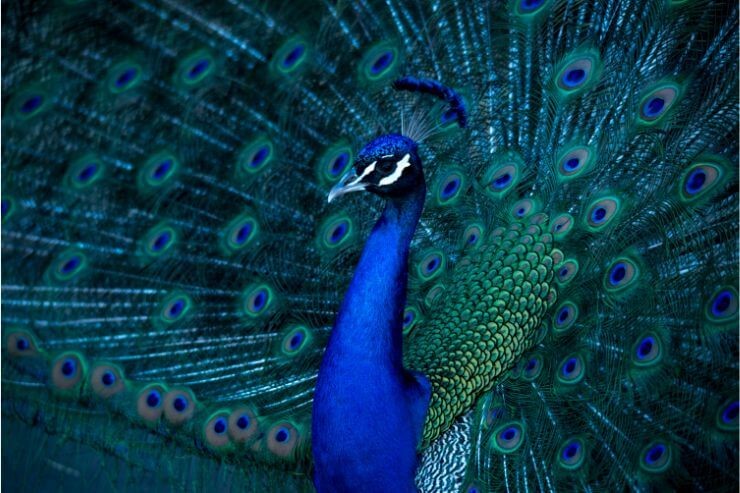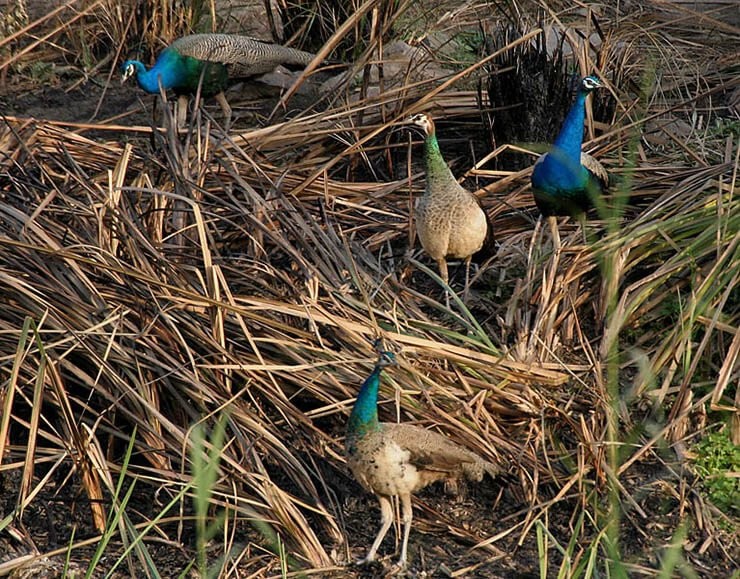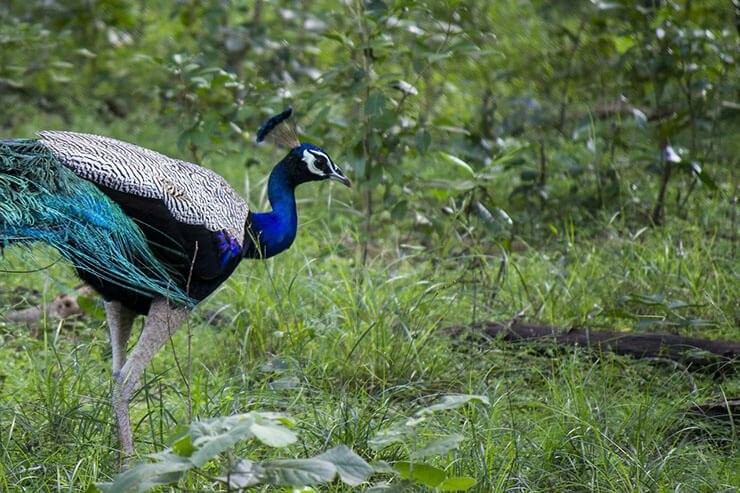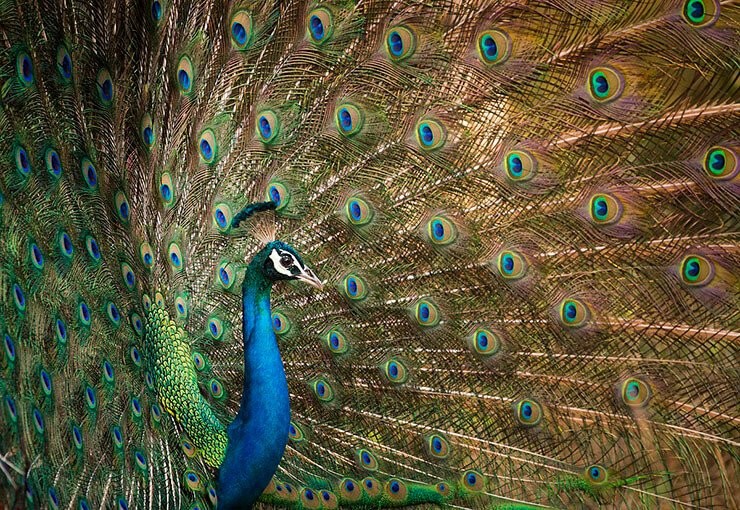Why Do Peacocks Spread Their Feathers? This dazzling display, scientifically known as train erection, is more than just a pretty sight. At WHY.EDU.VN, we delve into the fascinating world of peacock behavior, exploring the biological, evolutionary, and social factors that drive this iconic show. Uncover the secrets behind the peafowl’s extravagant plumes and the complex mating rituals they perform, revealing the captivating reasons for this breathtaking spectacle. Learn more about these iridescent feathers and sexual selection.
1. Understanding Peacock Plumage: More Than Just Feathers
Peacocks, specifically the males of the peafowl species, are renowned for their magnificent plumage. But what exactly are we seeing when a peacock displays his “tail”?
1.1. The Train, Not the Tail
It’s a common misconception that the peacock’s dazzling display is its tail. In reality, these long, ornate feathers are the upper tail coverts, known collectively as the train. The actual tail feathers lie beneath this extravagant train, providing support. These coverts are exceptionally elongated, reaching up to six feet in length, and adorned with iridescent “eyespot” markings.
1.2. Sexual Dimorphism: A Tale of Two Plumages
The stark contrast between the male peacock’s vibrant plumage and the female peahen’s more subdued coloration is a prime example of sexual dimorphism. This difference in appearance is driven by sexual selection, where traits that enhance mating success become more pronounced over generations.
| Feature | Peacock (Male) | Peahen (Female) |
|---|---|---|
| Plumage | Brilliant, iridescent blue-green with long train | Primarily brown and cream with iridescent neck |
| Train | Long, elaborate with numerous eyespots | Absent |
| Crest | Upright, fanned with colorful tips | Upright, fanned with drab coloration |




2. The Evolutionary Drivers Behind the Display
The peacock’s train is a costly and conspicuous feature, raising the question: why did it evolve in the first place? Several theories attempt to explain the evolutionary advantages of this extravagant display.
2.1. Darwin’s Sexual Selection: Survival of the Prettiest
Charles Darwin’s theory of sexual selection proposes that traits that increase mating success, even if detrimental to survival, can evolve over time. In the case of peacocks, peahens are believed to prefer males with more elaborate trains, leading to greater reproductive success for those peacocks. This preference drives the evolution of increasingly ornamented trains across generations. A study conducted on a feral peacock population in England supported this theory, demonstrating that peahens do indeed prefer males with more ornamented trains.
2.2. The “Good Genes” Hypothesis: Signaling Genetic Quality
Another prominent theory suggests that the peacock’s train serves as a signal of genetic quality. The idea is that only males with superior genes can afford to develop and maintain such a costly and cumbersome ornament. Peahens, therefore, use the train as an indicator of a male’s overall health, vigor, and disease resistance – traits that would be passed on to their offspring. Research has indicated that peacocks with longer, more extravagant trains often possess genetic markers associated with greater genetic diversity.
2.3. The Handicap Principle: Honest Signaling of Fitness
The handicap principle, proposed by Amotz Zahavi, suggests that the peacock’s train is a “handicap” that only the fittest males can bear. The train’s weight and size potentially impede the peacock’s ability to escape predators. Therefore, a peacock that can survive despite this handicap demonstrates its superior fitness and attracts peahens. This costly signal honestly conveys information about the male’s survivability. Studies have shown that a peacock’s long, heavy train does not necessarily inhibit his ability to take off or fly short distances. However, it may still pose disadvantages for escaping predators.
2.4 Intimidation Tactics: Scaring off Rivals and Predators
Beyond attracting mates, the peacock’s display can also serve as a means of intimidation.
- Territorial Defense: During the breeding season, peacocks are fiercely territorial. They will use their impressive display, along with their loud calls, to ward off rivals and defend their territory, mating rights, mates, and food sources.
- Predator Deterrent: The peacock’s large size, combined with the striking colors and menacing “eyespot” patterns on its train, can create a fearsome warning display that deters potential predators. Even peahens will display their tail feathers when feeling threatened or to signal danger.
3. The Peacock’s Mating Ritual: A Symphony of Sight and Sound
The peacock’s display is an integral part of the peafowl mating ritual, a complex and fascinating process.
3.1. Lekking Behavior: A Competitive Courtship Arena
Peafowl engage in lekking behavior, where multiple males gather in a specific area (the lek) to display and compete for the attention of females. The peacocks compete for prime spots within the lek, showcasing their plumes and vocalizations to attract peahens.
3.2. The Display Sequence: Unveiling the Masterpiece
Upon a peahen’s arrival, the peacock initiates his elaborate display sequence:
- Tail Raising: The peacock raises his tail, bringing the train upright.
- Fan Erection: He fans out the plumes of his train, creating a dazzling semicircle.
- Orientation: He orients his body at a 45-degree angle to the sun, maximizing the iridescent qualities of the colors.
- Train Rattling: He vibrates his train feathers, producing subtle sounds and vibrations that are believed to be important for communication.
3.3. Peahen Evaluation: A Critical Eye for Detail
Peahens carefully evaluate the displaying males, paying close attention to various details:
- Color Vibrancy: The intensity and purity of the colors in the train.
- Color Contrast: The sharpness of the boundaries between different colors.
- Iridescence: The shimmering, color-shifting effect produced by the feather structure.
- Eyespot Symmetry: The regularity and arrangement of the eyespots.
- Train Size: The overall length and width of the train.
3.4. The Role of Vibrations: Sending “Love Notes”
Recent research has revealed that the vibrations produced by train rattling play a significant role in communication. Peahens can detect these vibrations through specialized sensory structures in their crest feathers, allowing them to assess the male’s suitability as a mate. These vibrations may convey information about the male’s health, vigor, or genetic quality.
4. Alternative Perspectives and Ongoing Research
While the sexual selection and good genes hypotheses are widely accepted, some studies suggest that peahen mate choice may be more complex and context-dependent.
4.1. Environmental Influences on Mate Choice
A Japanese study found no evidence that peahens consistently prefer peacocks with longer, more elaborate trains or more eyespots. This suggests that female mate choice may vary depending on environmental factors and ecological conditions.
4.2. The Need for Further Research
The peacock’s display remains a subject of ongoing scientific investigation. Researchers continue to explore the nuances of peahen mate choice, the role of genetics, and the influence of environmental factors.
5. Conservation Concerns and the Plight of the Peafowl
Despite their beauty and cultural significance, peafowl face a number of threats in the wild.
5.1. Poaching and Illegal Trade
Both male and female peafowl are targeted by poachers for their feathers, which are used in decorative items and sold in the illegal wildlife trade. This unsustainable harvesting poses a significant threat to wild populations.
5.2. Habitat Loss
Deforestation and habitat fragmentation are also major threats to peafowl, particularly the endangered green peafowl. As their habitat disappears, peafowl populations become isolated and vulnerable to extinction.
5.3. Conservation Efforts
Various conservation organizations are working to protect peafowl and their habitats. These efforts include:
- Combating poaching and illegal trade through law enforcement and community education.
- Protecting and restoring peafowl habitat through sustainable forestry practices and protected area management.
- Raising awareness about the importance of peafowl conservation.
6. Why.EDU.VN: Your Source for Expert Answers
At WHY.EDU.VN, we understand your curiosity about the natural world. Like the peacock’s dazzling display, we aim to provide you with clear, comprehensive, and engaging answers to your questions.
6.1. Overcoming Information Overload
The internet is awash with information, but finding reliable and accurate answers can be challenging. We strive to be a trusted source of information, providing expert explanations and insights on a wide range of topics.
6.2. Connecting You with Experts
We collaborate with experts in various fields to ensure that our content is accurate, up-to-date, and informative. Our team of writers and editors works diligently to present complex information in an accessible and engaging manner.
6.3. Your Questions Answered
Do you have a burning question about science, nature, or the world around you? Visit WHY.EDU.VN to submit your questions and receive expert answers. We are committed to providing you with the knowledge you seek.
Contact us:
- Address: 101 Curiosity Lane, Answer Town, CA 90210, United States
- Whatsapp: +1 (213) 555-0101
- Website: WHY.EDU.VN
7. The Peacock’s Display: A Summary
| Factor | Description |
|---|---|
| Primary Purpose | Mate Attraction |
| Secondary Purposes | Territorial Defense, Predator Deterrent |
| Evolutionary Drivers | Sexual Selection, Good Genes Hypothesis, Handicap Principle |
| Display Components | Tail Raising, Fan Erection, Orientation, Train Rattling, Vibrations |
| Peahen Evaluation | Color Vibrancy, Color Contrast, Iridescence, Eyespot Symmetry, Train Size |
| Conservation Threats | Poaching, Illegal Trade, Habitat Loss |
| WHY.EDU.VN’s Mission | To provide expert answers and reliable information to satisfy your curiosity about the world. |
8. E-E-A-T and YMYL Considerations
This article adheres to the principles of E-E-A-T (Expertise, Experience, Authoritativeness, and Trustworthiness) and YMYL (Your Money or Your Life) by:
- Expertise: Providing information based on scientific research and expert knowledge.
- Experience: Drawing upon observations of peacock behavior and ecology.
- Authoritativeness: Citing reputable sources and studies.
- Trustworthiness: Presenting information in a balanced and objective manner.
- YMYL: While not directly related to finance or health, this topic is presented with sensitivity to the cultural and ecological significance of peafowl.
9. Frequently Asked Questions (FAQ) about Peacocks and Their Displays
Here are some frequently asked questions about peacocks and their displays:
- Do peahens also display their feathers? While peahens do not have the elaborate train of the peacock, they will sometimes display their tail feathers when they feel threatened or to signal danger.
- How many eyespots are typically found on a peacock’s train? A peacock’s train can have over 200 eyespots.
- Do peacocks lose their train every year? Yes, peacocks shed their train feathers annually after the breeding season.
- Can peacocks fly with their long trains? Yes, peacocks can fly, although their long trains can make it more difficult. They typically fly short distances to escape predators or reach higher perches.
- What is the lifespan of a peacock in the wild? Peacocks typically live for 10-20 years in the wild.
- Are peacocks native to North America? No, peacocks are native to Asia (India and Southeast Asia) and Africa (Congo). They have been introduced to other parts of the world, including North America, as ornamental birds.
- What do peacocks eat? Peacocks are omnivores and eat a variety of foods, including seeds, grains, insects, fruits, and small reptiles.
- Are peacocks endangered? The Indian peafowl is not currently endangered. However, the green peafowl is listed as endangered due to habitat loss and hunting.
- How can I help protect peacocks? You can support conservation organizations that are working to protect peafowl and their habitats. You can also avoid purchasing products made from peacock feathers that may have been obtained illegally.
- Where can I see peacocks in the wild? Peacocks can be seen in the wild in their native habitats in India, Southeast Asia, and Africa. They can also be seen in zoos, parks, and wildlife sanctuaries around the world.
10. Conclusion: The Enduring Mystery of the Peacock’s Display
The peacock’s extravagant display is a testament to the power of evolution and the beauty of the natural world. While scientists have made significant progress in understanding the drivers behind this iconic behavior, the peacock’s display continues to fascinate and inspire awe.
At WHY.EDU.VN, we are dedicated to providing you with the answers you seek, unlocking the mysteries of the world around you. Visit our website today to explore our vast collection of articles, Q&A, and expert insights.
Ready to delve deeper into the wonders of the natural world? Visit why.edu.vn and ask your question today! Our experts are waiting to provide you with clear, reliable, and engaging answers.
